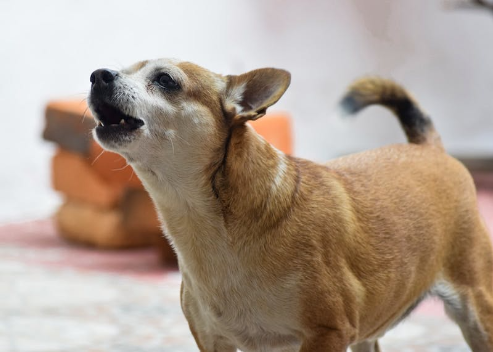So, you’ve got a dog that loses its marbles whenever it sees another hound? Welcome to the club! Dog-to-dog reactivity is like your pup’s way of saying, “I just don’t know how to deal with this. Please help me out here!” Brock used to lose it at anything within a 300-metre radius, not because he was aggressive but because he was so overexcited to see the world. He still struggles when we go to the vet, even after we’ve been playing disengagement games for 2 years. Cars can also be exciting, as can be his favourite hoomans. Some things are just beyond his ability to control himself even though we’ve gone from a 300-metre to a 3-metre threshold. Being the proud guardian to a reactive dog I’m here to give you my top 5 tips for training a pooch who just finds the world overwhelming.
Before we dive headfirst into this struggle, let’s get what we’re dealing with straight. Dog-to-dog reactivity is like your dog’s version of a soap opera – drama everywhere! They see another dog, and it’s barking, lunging, and growling like the world’s about to end. They can’t disengage with the world. Be bribed with a treat – forget it, they’re already over threshold and treats just don’t cut it. You can’t compete with an over threshold pooch.
Remember, the reaction you want from your dog is no reaction at all. Be as patient as a cat waiting for a mouse and stay consistent in reinforcing those positive associations your pup makes through playing loose leash walking and disengagement games. Celebrate the small wins and, when things go pear shaped, keep your chin up and take it back a step. If you’re feeling like a lost pup yourself, consider getting professional help from a positive dog trainer.
Tip 1
Train FOR the situation rather than IN the situation. Practice makes perfect so rehearse your leash technique in the back yard before you venture outside. It gives both you and your pup some muscle memory to work with. Practice Approach and Retreat, Getting Out Of Dodge, Middle on the Move, and other games so your dog understands that when you handle the leash in a particular way that you are going to turn around and move away from whatever Is overwhelming them. Do not engage in Flooding your dog. If you’ve attended training with me then I would have already explained Flooding. For those of you who have no idea, Flooding is when you overexpose a dog to a stimulus until their brain explodes and they just don’t have the energy to keep reacting. Think Exposure Therapy for humans, which is used to treat phobias, without asking consent. A great analogy is someone with a spider phobia. Do you ask consent to show the person a photo of a spider or do you throw a live one at them and tell them to deal with it? Flooding is throwing the spider at them. Not cool and it will only make the situation worse.
Tip 2
Start with minimal distractions. If your dog can’t see or hear anything to react to then they won’t react. Sounds easy, right? Nope, it’s tougher than it appears. Training in an environment where there are no distractions is a unicorn so start training in a familiar environment like your lounge room where you have a lot of control over distractions. As your pup (and you) become more confident then start introducing new noises, new sights and new environments. If they struggle when you change something, then take them back a step so you can both still have a Win. Utilise apps or audio of noises that might usually set your pup off the Richter scale but play them at a barely audible volume. Put on a movie with dogs in it (or check out YouTube) and be ready with the remote to turn it off or change the channel at the first hint of distress. Watch your dog’s body language closely and enlist a friend to drive the app or the remote while you deliver high value treats and praise Fido for not losing their marbles. You’ll want to use a rapid rate of reinforcement (popcorn feeding).
Tip 3
Watch out for those triggers. In psychology we call them antecedents. You may have heard of the ABC Model of behaviour modification. It’s used to explain and modify behaviour in many species. A = Antecedents, B = Behaviour, C = Consequences. A doggy example might be A = you ask your dog to sit, B = your dog sits, C = your dog receives a piece of food, or A = your dog sees another dog, B = your dog barks and runs forward, C = the other dog comes towards them to interact. Antecedents influence nearly everything in our dog’s lives. Your dog is a master at reading your body language. They know when you’re going out. They know when you’re settling in for a night in front of the TV. They know when you’re upset or happy. They know when you’re getting ready to take them for a walk. You name it and they know it. When you’re out in the big wide world we find that many hearing dogs listen out for other dog’s tags jingling (handy hint: get ID tags that sit flat on your dog’s collar), or for the sound of a car. Also, deaf dogs are very visual so they will be scanning their visual field for both exciting things and for what they might perceive as a threat. Brock loves birds, planes and Venus when it’s visible in the sky from our back garden.
Tip 4
Shake it off. Emotion is contagious and the leash is an umbilical cord. Your emotional state is just as important as your dog’s. If you’re freaking out at taking Fluffy for a walk then take a deep breath, strike a power pose, and take a step forward. That emotion goes both ways up and down the leash and you’ll just amp each other up. If you shake it off before you walk out the door or gate, then your Fido will soon realise that there’s nothing to worry about. Be guided by your dog’s emotional state. Sometimes it might mean that your walk is only out the front door and the straight back in again. Sometimes you might practice loose leash walking in the back garden. Other times you might get a great walk with no outbursts. Remember to practice FOR the situation rather than IN the situation. If either of you are stressed then ditch the walk and play some games at home.
Tip 5
Change up your equipment and your routine. You can often change the picture for your dog if you change your equipment, the time, the walking route, and sometimes even the person. Your pup has a picture of what a walk looks like. They might have this picture “When I get my harness on and Furmum gets my leash from the hook I can start getting amped up. I’m going to walk out the front door and look for any other dogs that might be exciting to say hi to, or to see if they might be scary and I’ll need to lunge and bark at them to get them to move away. Once we’re away from the house then Furmum will walk the same path, We walk past the social media post on the path where I get to sniff all the information that every male dog has left on the post. Then we turn left and go down the dip where I can see the ducks. They’re so much fun to bark at. After we go back up the hill then there’s that other dog that barks at me through the fence and I can drag Furmum along the fenceline so we can all have some fun.” Sound familiar? Try putting a different harness on, a new leash, a new time, a new route, or even get someone else to walk your pup. This will change their picture of what a walk will look like and you might get some very interesting information. Above all, when using new equipment please put safety first. It should fit Fido well so that they can’t back out of it or slip it off.
So, why does games-based training work so well for dog/dog reactive dogs? Well, it turns out that games are like doggy crack – irresistible and effective. Here’s why they’re a game-changer (pun totally intended) for tackling reactivity:
- Playing training games makes your dog feel like they’ve won the lottery because they have less stress in their lives and they know exactly how you’re going to help them with their overwhelm. They’ve practiced it and they know what’s coming next.
- Rewards, rewards, rewards. Fido knows that they’re going to get something amazing for giving you the behaviour that you’ve trained for.
- Memory Booster: When you’re having a blast, you remember things better, right? Same goes for your dog – games make the lessons stick. Sticky learning is the best learning.
Reactivity may have turned your pup into a bit of a drama queen, but games-based training can help transform them into the coolest pup on the street. So, unleash the fun and watch your furry friend evolve into a chill and all-around awesome companion. This journey is as rewarding as belly rubs and bacon treats, and your bond with your pup will be stronger than ever. Let the games begin and say goodbye to reactivity – it’s time for your dog to join the cool kids’ club!
Game on!
Let’s Play!
Hxx


